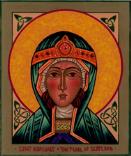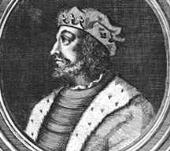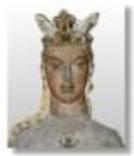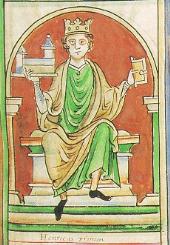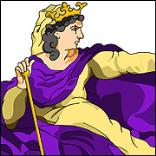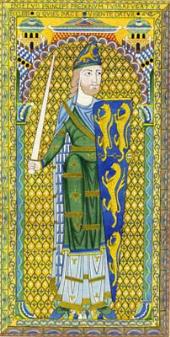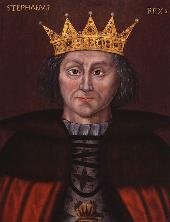See also
- Saint 's parents: Edward KING OF ENGLAND (UNCROWNED) (1016-1057) and Agatha of Brunswick (c. 1018-1024)
- Saint 's siblings: Edgar "Aetheling" PRINCE OF ENGLAND (c. 1051-c. 1126) and Christina PRINCESS OF ENGLAND (UNCROWNED) ( - )
Saint (1045-1093)
1. Saint Margaret "the Exile", daughter of Edward KING OF ENGLAND (UNCROWNED) (1016-1057) and Agatha of Brunswick (c. 1018-1024), was born in 1045 in Hungary. She died on [Julian] 16 November 1093 in Edinburgh Castle. She married Malcolm III KING OF SCOTLAND.
Saint Margaret 'the Exile' was the daughter of Edward 'Atheling' and Agatha. She was born in 1045 at Hungary. She married Malcolm III 'Caennmor', King of Scotland, son of Duncan I 'the Gracious', King of Scotland and Sybilla of Northumbria, in 1069 at Dunfermline Abbey, Dunfermline, Fife, Scotland. She died on 16 November 1093 at Edinburgh Castle, Edinburgh, Edinburgh, Scotland. She was buried at Dunfermline Abbey, Dunfermline, Fife. She was buried at Jesuit College, Douai, France.
She was the granddaughter of Edmund Ironsides and 7th in descent from Alfred the Great
In 1250 she was canonised as Saint Margaret.
Born about 1045, Princess Margaret was a daughter of Edward "Outremere", or "the Exile", and Agatha, kinswoman of Gisela, the wife of St. Stephen of Hungary . She was the granddaughter of Edmund Ironside.
The chief authority for Margaret's life is the contemporary biography printed in Roman " Acta SS .", II, June, 320. Its authorship has been ascribed to Turgot, the Saint's confessor, a monk of Durham and later Archbishop of St. Andrews, as well as to Theodoric, a somewhat obscure monk
The Norman conquest forced the Anglo Margaret and her family to flee to Scotland in 1070 where shortly thereafter she married the King, Malcom II (Canmore). As Queen and co-Regent, Margaret bore eight children (two daughters and six sons). She was known to have been a particularly involved and good mother - a departure from the contemporary practice of leaving the rearing of children to servants and tutors. Margaret's daughter Matilda married Henry I of England , making her an ancestress of the present British royal house.
Queen Margaret was renown for her moderating and good influence on her husband and for her devout piety and religious observance. As Queen, Margaret used her influence to bring Scotland into the more modern practices, disciplines of European Christianity and is celebrated as a clerical reformer. Though strong-willed, Margaret used reason and encouragement to influence change, not her authority as co-Regent and Queen. Under Queen Margaret's leadership the Rite of the Celebration of the Mass was brought under standardized norms, the vernacular of the Mass was changed from the many dialects of Gaelic spoken throughout Scotland to the unifying Latin, the Scots began to receive Communion regularly, and the observance of Lent was improved.
Although her influence in causing the clergy to adopt Latin to celebrate the Mass was intended as a tool by which all Scots could worship in unity, along with the other Christians of Western Europe, Queen Margaret's introduction of Anglo-Norman manners and values into Celtic Scotland laid the cultural groundwork for the future induction of her land and people into a greater England and Britain. While many hagiographers view Queen Margaret's goals as not simply uniting the Scots, but Scotland and England together as a way of ending bloody warfare amongst the clannish highlanders, Scotland returned to a period of isolation immediately following her death.
In 1093, King Malcom was murdered through treachery near Alnwick and was buried at Dunfermline Abbey, which had been founded by in 1072 Margaret. She foretold the day of her death, joining her husband's eternal rest on 16 November 1093, her body being buried before the high altar at Dunfermline.
In 1250, Queen Margaret was canonized by Innocent IV, and her relics were translated on 19 June, 1259, to a new shrine, the base of which is still visible beyond the modern east wall of her restored chapel. At the Reformation her head passed into the possession of Mary Queen of Scots, and later was secured by the Jesuits at Douai , where it is believed to have perished during the French Revolution. According to George Conn, " De duplici statu religionis apud Scots " (Rome, 1628), the rest of the relics, together with those of Malcolm, were acquired by Philip II of Spain, and placed in two urns in the Escorial. When, however, Bishop Gillies of Edinburgh applied through Pius IX for their restoration to Scotland , they could not be found.
St. Margaret is remembered for her fervent faith, practiced piety and religious observance and continues to be celebrated as Scotland's most beloved saint. St. Margaret was loved by the poor, especially orphans to whom she was particularly attached in personal care and through the unceasing distribution of alms. She was the foundress of many churches, convents and monasteries, including the Abbey of Dunfermline, built to enshrine her greatest treasure, a relic of the true Cross. Her book of the Gospels, richly adorned with jewels, which one day dropped into a river and was according to legend miraculously recovered, is now in the Bodleian library at Oxford . St. Margaret's son King David of Scotland is also celebrated by the people of Scotland as a Saint.
Feast of St. Margaret of Scotland
The feast of St. Margaret is observed by the whole Roman Catholic Church on 10 June. The Episcopal Church Commemorates St. Margaret each year on the Sunday closest to the anniversary of her death November, 16 th .
This is the fast that I choose, says the Lord: to share your bread with the hungry, and bring the homeless poor into your house; when you see the naked, to cover them, and not to hid yourself from your own kin. Isaiah 58:6-7.
Malcolm III KING OF SCOTLAND, son of Duncan I KING OF SCOTLAND (c. 1001-1040) and Sybilla of Northumbria ( - ), was born circa 1031. He died on [Julian] 13 November 1093. He and Saint Margaret "the Exile" had the following children:
| +2 | |
| +3 |
Second Generation
2. Editha of Scotland (known as 'Matilda'), daughter of Malcolm III KING OF SCOTLAND and Saint Margaret "the Exile", was born circa 1079 in Dunfermline, Fife, Scotland. She had the title 'Queen Consort Matilda'. She married Henry I KING OF ENGLAND on [Julian] 11 November 1100. She died on [Julian] 1 May 1118 in Westminster Palace.
Sister of Edmund, Edgar and David I (The Saint) Kings of Scotland. As of 11 November 1100, her married name was Queen Consort Matilda of England.
Henry I KING OF ENGLAND, son of William I KING OF ENGLAND (c. 1027-1087) and Matilda de Flandre (1032- ), was born in [Julian] September 1068. He married Adeliza of Louvain on 2 February 1121. He died on [Julian] 1 December 1135. He was buried in Westminster Abbey. He and Editha of Scotland had the following children:
| +4 |
3. Mary of Scotland, daughter of Malcolm III KING OF SCOTLAND and Saint Margaret "the Exile", married Eustace III EARL (COUNT) OF BOLOINE.
Eustace III EARL (COUNT) OF BOLOINE, son of Eustace II, Gernobadatus EARL (COUNT) OF BOLOINE (c. 1030-1087) and Ida von Niederlothringen (of Moselle & Lorraine) (1040-1113), died circa 1125. He and Mary of Scotland had the following children:
| +5 |
Third Generation
4. Matilda of Normandy EMPRESS OF ENGLAND, daughter of Henry I KING OF ENGLAND and Editha of Scotland, was born circa [Julian] August 1102. She died on [Julian] 10 September 1167. She married Geoffrey V PLANTAGENET.
Geoffrey V PLANTAGENET was born on [Julian] 24 August 1113. He had the title 'Comte d'Anjou et Maine'. He died on [Julian] 7 September 1151. He and Matilda of Normandy EMPRESS OF ENGLAND had the following children:
| 6 | Henry II KING OF ENGLAND (1133-1189). Henry was born on [Julian] 5 March 1133. He had the title 'King of England'. He died on [Julian] 6 July 1189. |
5. Matilda de BOULOGNE, son of Eustace III EARL (COUNT) OF BOLOINE and Mary of Scotland, died in 1151. He married Stephen de Blois, Count of Mortain KING OF ENGLAND.
Stephen de Blois, Count of Mortain KING OF ENGLAND was the daughter of Stephen COUNT OF BLOIS ( - ) and Adela of England ( - ).
